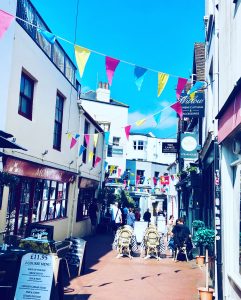While the rhetoric in Britain proclaims a cafe-style urban renaissance in towns and cities, policy is fast heading in the opposite direction under the guise of what is known as “retail-led development”, which roughly translates as “shopping makes places”.
.
Our town centres need to be vibrant, attractive places:
.
Some 14 years ago, the investigative journalist Anna Minton was asking if the latest report on high streets and town planning did not bode well:
.
Political footfall
The Barker review will show that the UK is failing to learn from mainland Europe how to make cities attractive for reasons other than chain-store shopping
The publication of economist Kate Barker’s interim planning review last month received limited media coverage… Although it may seem that the language of productivity and enterprise has little to do with our streets and public spaces, Barker’s review made it clear that the present emphasis on economic growth above all else will have an enormous impact on Britain’s urban environment.
The review quoted a report from management consultants McKinsey arguing that the problem with many UK shops is that there is “a greater proportion of UK employment in relatively [economically] inefficient corner shops and specialist shops”. It adds that shops of 3,000 sq metres are far more efficient than the average UK shop size of 500 sq metres, and implies that big stores, both in town centres and out of town, will be encouraged…
Jan Gehl, the architect credited with turning around the city of Copenhagen, says: “If you asked people 20 years ago why they went to central Copenhagen, they would have said it was to shop. But if you asked them today, they would say it was because they wanted to go to town [to take in the atmosphere].” Gehl’s focus on creating public space has been remarkable for the Danish capital, with four times as many people spending time in the city. Its thriving public life is widely acknowledged as something to emulate.

But while the rhetoric in Britain proclaims a similar cafe-style urban renaissance in towns and cities, policy is fast heading in the opposite direction under the guise of what is known as “retail-led development”, which roughly translates as “shopping makes places”.
The Treasury-commissioned Barker review indicates that it now seems almost certain that policy will be further strengthened towards retail-led development, but the public is in favour of the opposite.
In Brighton, for example, the success and popularity of the rabbit warren of streets known as The Lanes rests on the fact that many of the buildings are listed and cannot expand, thus producing a fertile breeding ground for browsing around the numerous tiny boutiques or stopping at offbeat bars and restaurants. Of course, the area may not provide the economies of scale of a Walmart, but it is an attraction all the same.
The fear is that places such as The Lanes are becoming the exception to the rule. In Paris, French policy makers have become so concerned about the British experience that they have described the trend as “la Londonisation” and have introduced planning regulations specifically to prevent it. As a result, about half the shops in Paris will have restrictions placed on them to prevent changes of use, so that a foodshop remains a foodshop and a bookshop or a greengrocer cannot become part of a mobile phone chain…